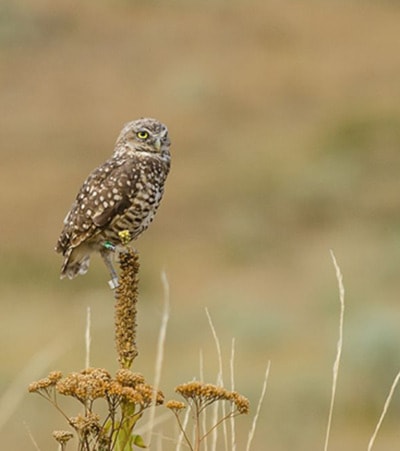NCC // Sage and Sparrow Conservation Area from Limelight Studios on Vimeo.
Don’t expect to get up close and personal with most of the wildlife found on a newly established conservation area southwest of Osoyoos.
“This is an area with cactus and scorpions and rattlesnakes and a lot of things that we associate with deserts,” said naturalist Dick Cannings.
“A lot of them aren’t cute and cuddly things.”
The Nature Conservancy of Canada announced Thursday it has acquired from a local ranching family 743 hectares of desert grassland where those critters live adjacent to Kilpoola lake down to the U.S. border.
Purchased for $4.4 million, the land adjoins two other plots owned by the conservancy to form a 3,000-hectare expanse now known as the Sage and Sparrow Conservation Area.
Scientists have identified at least 30 species at risk within the area, including burrowing owls, which are “very precariously perched on the edge of disappearing because it has already disappeared and we’re trying to bring it back,” said Cannings.
“It only occurs on that site because the Burrowing Owl Conservation Society is releasing birds into artificial burrows there that they dug and are trying to get a breeding population established.”

Cannings, who’s also a member of the conservancy’s regional board, said that like most places in the Okanagan, the biggest threat to the Sage and Sparrow Conservation Area is people.
“This habitat is easy to develop and this is where, as soon as broad settlement started occurring a hundred years ago, this was the first habitat to be lost,” he explained.
“It’s easy to build on. Think of all the orchards and vineyards and houses in the Okanagan: That’s the habitat it replaced.”
Creating conservation areas, he explained, helps balance the needs of people and nature.
“We’re not going to stop development in this valley, but I think we have to plan carefully how it happens to maintain our quality of life as well as the lives of other creatures,” said Cannings.
A majority of funding for the acquisition came from the federal government, while the balance was provided by 10 non-profits and individuals, said Barb Pryce, the conservancy’s Southern Interior program director.
Now the group intends to draw up a plan to protect the area in perpetuity.
“We’ve conducted a baseline inventory on the property and so what it tells us is the story of the land: What are the ecosystems there? What are some of the plants? What are the animals? What are the needs for stewardship?
“And from there we create a property management plan and that drives what we do on the land,” Pryce explained.
She will now turn her attention to a property in the Nicola region that has drawn the conservancy’s interest.
“Our work is never done,” Pryce said.
FACTS:
— This grassland ecosystem is one of the four most endangered ecosystems in Canada.
— The area is home to a diverse range of amphibian, reptile, bird and mammal species, some of which are not found anywhere else in Canada, nor in the world.
— This landscape is a crucial migratory corridor for species moving between the desert areas of the western U.S. and the dry grasslands of Interior B.C.
